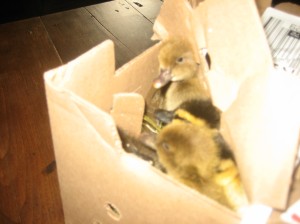The ducks arrived 2 days after the chickens, the same day the moving truck arrived, so it’s a bit of an understatement when I say the day was a blur. However, I did manage to get photographic evidence of how much cuter baby quacks are than baby peeps. Behold:
 For lack of planning, we put the ducks in with the chickens in the basement, and they all got along fine. Especially since we were feeding them both the same food.
For lack of planning, we put the ducks in with the chickens in the basement, and they all got along fine. Especially since we were feeding them both the same food.

Watching the ducks eat is pretty much the best part. The food is a bit too dry for them (bills vs. beaks), so they run back and forth from the feeder to the water jug, where they do the same sort of slurping thing that wine connoisseurs do when they suck air in over the wine to aerate it (or at least that what it sounds like to me). The constant parade is adorable.
We stuck with this arrangement for about two weeks, but we started running out of real estate fast. Ducks grow remarkably quickly, so we moved the quack clan out to the shed where we could make a bigger circle, leaving the chicks in the basement.
 At about 3 weeks, even this seemed crowded. The weather was consistently in the mid nineties, with evenings staying in the seventies, so we decided we could forgo the last week of living under the heat lamps and move them to the old chicken enclosure the previous property owners built from cedars they’d harvested from the woods at the back of the pasture.
At about 3 weeks, even this seemed crowded. The weather was consistently in the mid nineties, with evenings staying in the seventies, so we decided we could forgo the last week of living under the heat lamps and move them to the old chicken enclosure the previous property owners built from cedars they’d harvested from the woods at the back of the pasture.
 We were excited because the ducks are super messy, spilling their water everywhere and making it difficult to keep things clean (and not horribly smelly) in an indoor space. While catching them was a bit of a traumatic experience for the quacks, they were thrilled to nibble on the fresh green grass and adjusted quickly to life outdoors. Unfortunately, they refused to put themselves away in the little a-frame coop, preferring instead to sleep underneath it. Also unfortunate, we failed to notice some holes in the chicken wire, and the second night a fox managed to grab two of the Rouens. This prompted a trip to Southern States to purchase coyote urine… yes, I said I bought animal urine. Being a rookie, I had no idea what to get, and I was honestly embarrassed about having to inquire about it, so I got both granular and liquid urine. That, and some serious patching, seems to have done the trick, as we haven’t lost any other birds since then.
We were excited because the ducks are super messy, spilling their water everywhere and making it difficult to keep things clean (and not horribly smelly) in an indoor space. While catching them was a bit of a traumatic experience for the quacks, they were thrilled to nibble on the fresh green grass and adjusted quickly to life outdoors. Unfortunately, they refused to put themselves away in the little a-frame coop, preferring instead to sleep underneath it. Also unfortunate, we failed to notice some holes in the chicken wire, and the second night a fox managed to grab two of the Rouens. This prompted a trip to Southern States to purchase coyote urine… yes, I said I bought animal urine. Being a rookie, I had no idea what to get, and I was honestly embarrassed about having to inquire about it, so I got both granular and liquid urine. That, and some serious patching, seems to have done the trick, as we haven’t lost any other birds since then.
And now, those ducks are huge!















